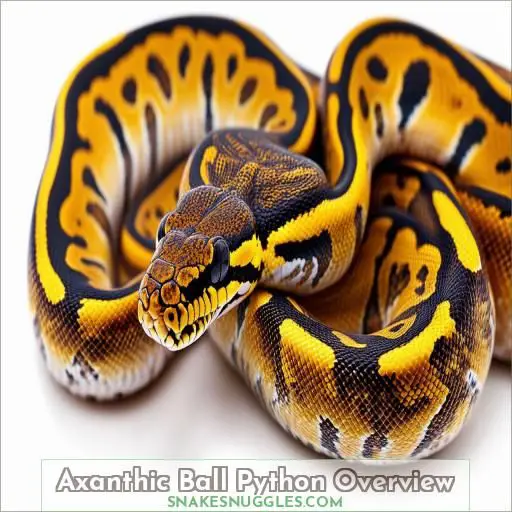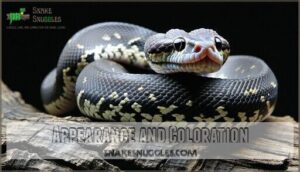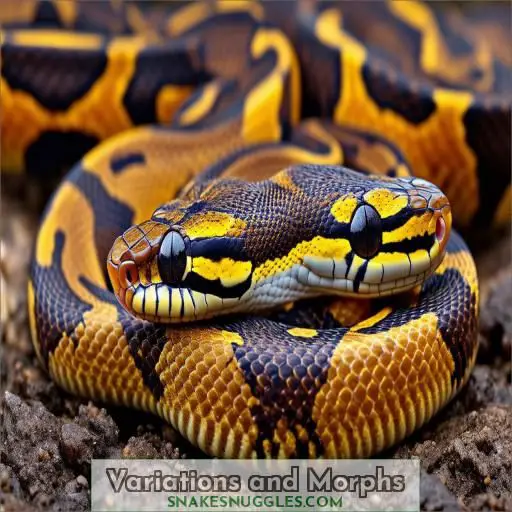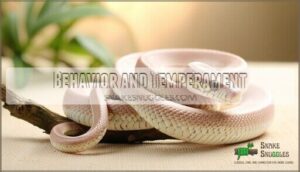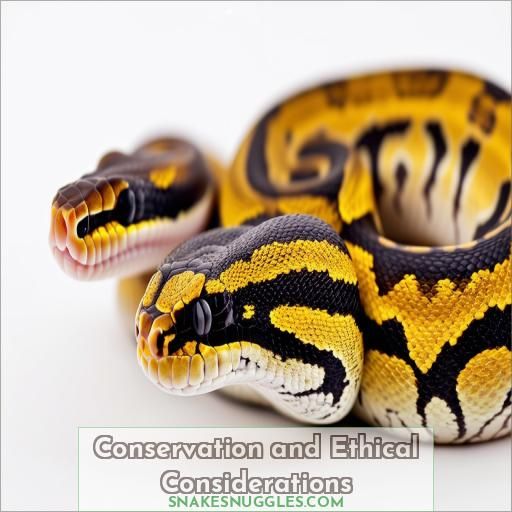This site is supported by our readers. We may earn a commission, at no cost to you, if you purchase through links.
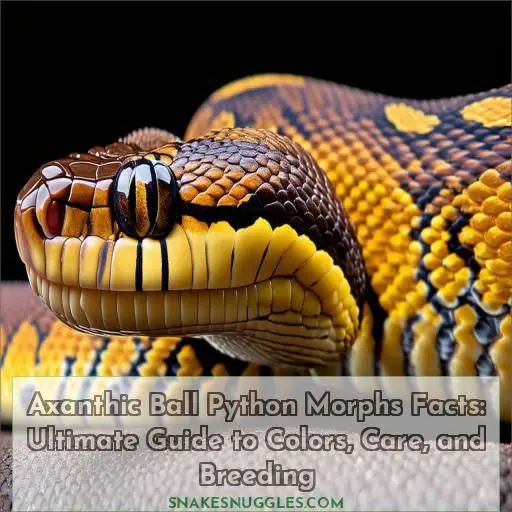 You’re about to unveil the enthralling world of axanthic ball python morphs, where Mother Nature flaunts her most exquisite hues. These snakes sport a genetic quirk that inhibits yellow pigment, resulting in a breathtaking palette of silvers, grays, and obsidian blacks.
You’re about to unveil the enthralling world of axanthic ball python morphs, where Mother Nature flaunts her most exquisite hues. These snakes sport a genetic quirk that inhibits yellow pigment, resulting in a breathtaking palette of silvers, grays, and obsidian blacks.
From the enhanced VPI line to the intricately patterned Mojave and Spider mixes, axanthic morphs mesmerize with their uniqueness. Proper care involves warm, humid environments and a diet of rodents.
But the real treasure? Discovering the intricate genetics and ethical breeding practices that bring these mesmerizing reptiles to life. Intrigued? Let’s delve deeper.
Table Of Contents
- Key Takeaways
- Axanthic Ball Python Overview
- Appearance and Coloration
- Genetics and Breeding
- Variations and Morphs
- Distribution and Habitat
- Care and Husbandry
- Behavior and Temperament
- Popularity and Demand
- Conservation and Ethical Considerations
- Frequently Asked Questions (FAQs)
- What are the characteristics of the Axanthic ball python?
- What do Axanthic ball pythons eat?
- What is the most sought after ball python morphs?
- What is the prettiest ball python morph?
- What are the rarest axanthic ball python morphs?
- How much do high-end axanthic ball pythons cost?
- Are axanthic ball pythons more prone to health issues?
- Can axanthic ball pythons be bred with other morphs?
- Conclusion
Key Takeaways
- These ghostly beauties lack the golden yellows typical of their wild kin, resulting in spellbinding shades of silver, gray, and obsidian that’ll make your jaw drop.
- With careful breeding programs, reptile wizards can conjure up bewitching combos like the Mojave Axanthic or Spider Axanthic – snakes so striking they could stop traffic!
- While axanthics may seem as rare as a desert oasis, dedicated breeders have turned these scaly unicorns into attainable pets through years of passion and perseverance.
- Sure, their ethereal looks grab the spotlight, but let’s not forget – behind the scenes, responsible ownership and ethical breeding are the real MVPs ensuring these snakes thrive for generations to come.
Axanthic Ball Python Overview
Axanthic ball pythons are an enthralling morph with distinct recessive genetics that inhibit yellow pigment production. These pythons naturally occur in Sub-Saharan Africa‘s grasslands but are exceptionally rare in the wild.
They’re primarily a product of captive breeding, first reliably achieved in 1997.
Ethical considerations are important when breeding these snakes to ensure the well-being of the animals.
Their unique mutation and rarity make them popular among enthusiasts (Source).
Appearance and Coloration
Axanthic Ball Pythons showcase a unique appearance with lack of yellow pigment, resulting in shades of gray, silver, and black. Their markings and patterns are reduced, giving them a striking, darker look, often accompanied by clear or pale eyes.
Base Colors
Exploring the Axanthic Ball Python‘s base colors, you’ll notice they lack yellow pigments, showcasing hues like light gray, silver, brown, and black. This unique coloration results from a recessive genetic mutation, enhancing their appeal. In captivity, these color variations make them a preferred choice, adding to their suitability as pets.
Markings and Patterns
Axanthic Ball Pythons exhibit distinctive markings and patterns due to their recessive genetics. You’ll notice:
- Line breeding can refine these patterns.
- Outcrossing introduces new genes.
- Co-dominance creates striking combinations.
- Polygenic inheritance influences shading.
- Epistasis can mask or modify markings.
Their unique appearance makes them fascinating subjects for any reptile enthusiast.
Eye Color
axanthic ball python morphs exhibit distinct eye color, often pale or clear, enhancing their overall exotic appearance. This eye color adds contrast to their cool-toned patterns, making them even more striking and unique. Due to this distinctive genetic trait, their eye color contributes to their rarity and desirability in the exotic pet trade.
Genetics and Breeding
In axanthic ball pythons, a recessive genetic mutation inhibits the production of yellow pigments, resulting in a unique, pale coloration. When breeding, heterozygous individuals carry this trait without expressing it, while homozygous individuals visibly exhibit the axanthic phenotype .
Recessive Trait
The Axanthic mutation, a recessive genetic trait, inhibits yellow pigment production, resulting in the unique, rare color variations you see. To express this trait, both parents must carry the gene. This distinctive coloration adds to their appeal as constrictors and ambush hunters, making them a popular choice in captive breeding programs.
Heterozygous Vs Homozygous
In axanthic ball pythons, understanding the differences between heterozygous (het) and homozygous (visual) individuals is vital. Here are key points:
- Heterozygous: Carries the recessive mutation, doesn’t show it.
- Homozygous: Expresses the mutation visibly.
- Breeding: Two hets can produce homozygous offspring.
- Color: Homozygotes lack yellow pigments.
Breeding Combinations
Breeding Axanthic Ball Pythons involves understanding Axanthic morph genetics. By breeding two homozygous Axanthics, you’ll get only Axanthic offspring, showcasing VPI line characteristics. Heterozygous pairs carry the trait without displaying it, producing 25% Axanthic offspring. Color variations in axanthics can vary, and breeding challenges include ensuring genetic diversity.
Variations and Morphs
In exploring Axanthic ball python morphs, you’ll encounter various morphs such as the VPI line, which enhances pale coloration, and combinations like Mojave and Spider that add distinct patterns. Each morph offers unique visual traits while maintaining the core genetic characteristics of the Axanthic ball python (Source).
VPI Line
The VPI line is renowned for its unique axanthic mutation, primarily enhancing pale coloration by inhibiting yellow pigment production. Variations like the VPI Mojave and VPI Spider further diversify this line. Despite being rare in the wild, they’re popular among breeders and enthusiasts due to their striking appearance and relatively easy care.
Mojave and Spider Combinations
Combining the Mojave and Spider morphs with Axanthic traits creates stunning ball python variations. These combinations emphasize unique patterns and enhanced color contrasts. Key advantages include:
- Distinct Patterns: Mojave Spiders exhibit intricate, web-like markings.
- Genetic Diversity: Axanthic genes enrich coloration.
- Breeder Appeal: These morphs are highly sought after for their visual allure.
Other Axanthic Morphs
Exploring Axanthic morphs, you’re likely to encounter variations like Axanthic Black Pastel or Axanthic Pinstripe. These unique color variations, produced through selective breeding projects, exhibit a fascinating blend of dark and light hues. Understanding axanthic color variation can enhance your breeding projects and help ensure better adaptation to their natural habitat, promoting conservation efforts .
Distribution and Habitat
Axanthic ball pythons, native to Sub-Saharan Africa, are primarily found in grasslands and savannas, reflecting the typical habitats of their parent species . These unique morphs are extremely rare in the wild but are widely available for purchase through specialized reptile breeders who cater to the high demand for their distinctive appearance and genetics .
Native Range
Axanthic Ball Pythons trace their origin to Sub-Saharan Africa, thriving in the grassland and savanna regions. They belong to the VPI lineage, which began with selective breeding to enhance their pale coloration. Despite their wild scarcity, captive breeding programs have led to their proliferation, making them increasingly available to enthusiasts.
Wild Occurrence
In the wild, Axanthic Ball Pythons are incredibly rare. Native to Sub-Saharan Africa, they primarily inhabit grasslands and savannas. Wild populations face significant threats due to habitat loss and natural selection pressures. Conservation efforts are paramount to protect these unique snakes, despite their rarity and the predominance of captive breeding practices .
Captive Breeding
Captive breeding of Axanthic Ball Pythons has become essential for maintaining genetic diversity and breeding programs. Breeders focus on:
- Genetic inheritance: Ensuring recessive traits are passed on
- Morph development: Creating new, desirable morphs
- Breeding programs: Structured plans for healthy populations
- Genetic diversity: Avoiding inbreeding for robust offspring
Care and Husbandry
When caring for axanthic ball pythons, you’ll need to provide a warm, humid environment that mimics their natural habitat. Their diet typically includes small rodents, which should be offered at regular intervals to ensure proper nutrition (Source).
Housing Requirements
For appropriate housing, your Axanthic Ball Python thrives in a secure, well-ventilated terrarium. Ideal enclosure size is 40 gallons for adults. Use a substrate like aspen shavings or cypress mulch. Lighting needs are minimal, with optional UVB light. Decor options include hides and branches. Place water in a stable, shallow bowl.
| Aspect | Requirement | Additional Notes |
|---|---|---|
| Substrate | Aspen/Cypress Mulch | Maintain cleanliness, avoid cedar |
| Enclosure Size | 40 Gallons | Adequate space for adult pythons |
| Lighting | Optional UVB | Provides additional Vitamin D |
| Water Placement | Shallow Bowl | Ensure stability, avoid contamination |
Temperature and Humidity
Maintaining suitable temperature gradients and humidity ranges is vital. Your axanthic ball python’s enclosure should have a warm side at 88-92°F and a cooler side around 78-80°F . Humidity should stay between 50-60% . Use substrates like cypress mulch to help maintain these conditions effectively .
Feeding and Diet
Now let’s delve into feeding and diet. To maintain the health of your Axanthic Ball Python, consider these necessities:
- Growth Rate: Regular feedings contribute to optimal growth.
- Feeding Frequency: Feed juveniles weekly, adults less frequently.
- Prey Size: Adjust prey size to align with the python’s girth.
- Nutritional Supplements: Generally not required with a balanced diet.
Ensure suitable temperature and humidity for proper digestion .
Behavior and Temperament
Axanthic ball pythons are generally docile and make great captive pets. Though, they may display defensive behaviors like coiling, hissing, or striking if they feel threatened or are mishandled.
With proper socialization and gentle handling from a young age, these snakes can become quite tame and tolerant of human interaction. They live around 20-30 years on average when provided with appropriate care.
Defensive Behaviors
Axanthic ball pythons, while docile, display defensive behaviors when provoked. When threatened, they may coil, hiss, musking. Their bite, while non-venomous, can inflict pain due to rear-facing teeth. Monitoring stress signs like excessive hiding and reduced appetite prevents escalation.
| Signs | Description |
|---|---|
| Coiling | Tight spiral stance |
| Hissing | Forceful exhalation |
| Musking | Releasing foul scent |
| Striking | Biting if cornered |
| Hiding | Seeking refuge |
Handling and Interaction
When properly socialized, axanthic ball pythons become docile pets. Gentle handling and cage enrichment promote confidence. Veterinary care guarantees healthy handling experiences. Breeding axanthics requires specialized techniques, enriching your mastery. With innovation and control over their environment, you’ll find handling axanthics highly rewarding.
Lifespan
You’ll be delighted to know these beautiful snakes boast impressive lifespans when properly cared for. In captivity, they can thrive for 20-30 years with the right diet, habitat, and preventative care. Monitor their health closely, addressing any issues promptly to maximize longevity. Proper breeding techniques also enhance overall vigor for generations of axanthic beauty.
Popularity and Demand
Axanthic ball python morphs, with their striking pale coloration and unique genetic heritage, have captivated reptile enthusiasts worldwide. Their rarity and high demand, coupled with the challenges of selective breeding, make these visually appealing snakes highly coveted and valuable additions to any collection.
Rarity and Uniqueness
Due to their unique appearance, axanthic ball pythons are highly sought after and in great demand. Their genetic rarity, combined with striking color variations and scalation patterns, sets them apart, alluring reptile enthusiasts. This exclusivity fuels their popularity as prized collectibles among discerning herpetoculturists.
Cost and Availability
Due to their uniqueness and breeding potential, Axanthic ball pythons command high prices on the reptile market. Their availability varies based on morph combinations, geographical distribution, and overall market trends. Proper husbandry considerations also influence cost and accessibility for these coveted snakes.
Desirability as Pets
Axanthic ball pythons’ unique appearance and docile nature make them highly desirable pets. You’ll find they:
- Offer striking color combinations
- Have calm, easy-going temperaments
- Are relatively simple to care for
- Satisfy the collector’s desire for novelty
Their popularity soared after captive breeding programs succeeded in stabilizing the VPI line. However, ethical breeding and ownership remain important considerations.
Conservation and Ethical Considerations
While axanthic ball pythons are popular in the pet trade due to their unique appearance, it is imperative to comprehend the conservation status of their wild populations. It is also important to guarantee responsible captive breeding practices.
As captive-bred specimens can meet the demand for these morphs as pets, supporting programs that prioritize the ethical and sustainable production of axanthic ball pythons aids in protecting wild snake populations from overexploitation.
Wild Population Status
Axanthic ball pythons in the wild are incredibly rare due to genetic variation. Their pale coloration makes survival challenging, leading to low wild population numbers. This rarity impacts genetic diversity, so conservation efforts focus on preserving these unique morphs. Responsible captive breeding programs help sustain axanthic populations while minimizing impact on wild counterparts.
Captive Breeding Programs
Captive breeding is critical for safeguarding axanthic genetics. Specialized techniques guarantee color inheritance while observing habitat preferences. It fuels conservation by responsibly managing captive populations—a strategy essential for this recessive morph’s future accessibility.
Responsible Ownership
You play a significant role in promoting ethical ownership. Adhering to responsible care guidelines, supporting conservation efforts, and educating others about captive breeding practices contribute to the responsible flourishing of these unique pythons. Embracing a mindful approach to ownership safeguards their well-being while appreciating their remarkable beauty and uniqueness.
Frequently Asked Questions (FAQs)
What are the characteristics of the Axanthic ball python?
The Axanthic ball python lacks yellow pigmentation, resulting in shades of gray, brown, and silver. Its markings appear reduced compared to wild types, giving it a striking, muted appearance.
What do Axanthic ball pythons eat?
You’d think these snakes only eat fancy fare, but irony strikes – they’ll happily devour simple rodents, just like their regularly-colored cousins. Don’t let their unique appearance fool you; underneath, they’re still classic ball pythons.
What is the most sought after ball python morphs?
You crave the rarest, most coveted ball python morphs like the scaleless and piebald. Their unique traits and limited availability make them highly prized by elite breeders and collectors.
What is the prettiest ball python morph?
You may find the Bongo morph breathtakingly beautiful with its vibrant orange and yellow shades contrasted by dark patterns.
What are the rarest axanthic ball python morphs?
Some rarest axanthic ball python morphs include Acid, Banana, and Scaleless. These snakes are highly coveted by collectors for their unique lack of yellow pigmentation combined with other exotic traits. You’ll need deep pockets and patience to acquire such exquisite specimens.
How much do high-end axanthic ball pythons cost?
High-end axanthic ball pythons easily fetch $1,000-$5, Elite combos and ultra-rare morphs command premium prices, even exceeding $10,000 from reputable breeders. For these coveted serpents, you’ll need serious cash on hand.
Are axanthic ball pythons more prone to health issues?
No, axanthic ball pythons aren’t inherently prone to health issues. When cared for properly, they’re just as hardy as any other ball python morph.
Can axanthic ball pythons be bred with other morphs?
Curling corridors of curiosity capture creative combos! Yes, axanthic ball pythons prove plucky partners for pristine pairings with many morphs. Mastering precise mating methods maximizes magnificent, marketable morphs.
Conclusion
Exploring the enchanting world of axanthic ball python morphs demands commitment to ethical breeding practices and responsible care. These captivating serpents, with their silvery hues and intricate patterns, offer a glimpse into nature’s artistry.

